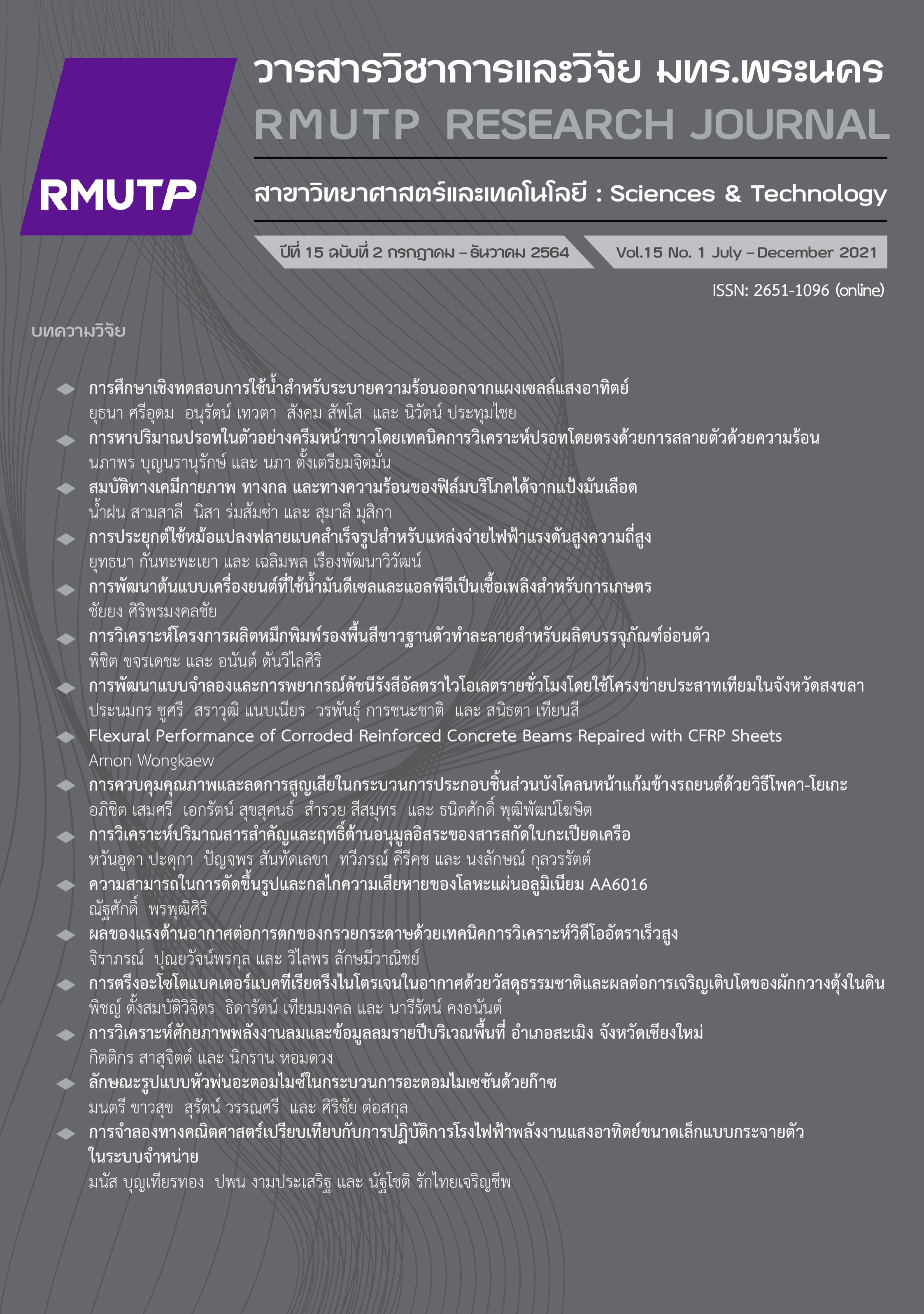Development of a Model and Forecasting of Hourly UV Index Using Artificial Neural Network (ANN) at Songkhla
Main Article Content
Abstract
In this work, solar erythemal ultraviolet radiation (EUV) which affects human skin and skin cancer was investigated at Songkhla province (7.2°N, 100.6°E). EUV was converted to UV index, then the data was used for model development and forecasting of hourly UV index using Artificial Neural Network (ANN). The ANN model has one input layer, two hidden layers and one output layer. This input layer consists of extraterrestrial erythemal ultraviolet radiation, solar zenith angle, aerosol optical depth and cloud index which affect ultraviolet radiation, and the output layer is hourly UV index. The results show that hourly UV index obtained from ANN and that from the measurement are in reasonable agreement, with root mean square difference of 12.8% and mean bias difference of -2.4%. For forecasting of the hourly UV index, the data for 7 days earlier was used for forecasting the next UV index for one day or nine-hour (08:00 am.-16:00 pm.). Multi-layer perceptron and back propagation algorithm were used in the model forecasting. The results show that the UV index from the model forecasting is reasonable agrees with UV index from measurement with root mean square difference of 17.0% and mean bias difference of 0.3%.
Article Details

This work is licensed under a Creative Commons Attribution-NonCommercial-NoDerivatives 4.0 International License.
ลิขสิทธ์ ของมหาวิทยาลัยเทคโนโลยีราชมงคลพระนครReferences
WHO, O.M.d.l Santé, Global Solar UV Index: A Practical Guide, A joint recommendation of World Health Organization, World Meteorological Organization, United Nations Environment Programme, International Commission on Non-Ionizing Radiation Protection, WHO, Geneva, 2002.
A. A. Ghoneim, I.M. Kadad and M.S. Altouq, “Statistical analysis of solar UVB and global radiation in Kuwait,” Energy, vol. 60, pp. 23-34, 2013.
G.W. Petty, A First Course in Atmospheric Radiation, Sundog Publishing, Madison, Wisconsin, 2004.
L. Wang, W. Gong, Y. Ma, B. Hu, W. Wang and M. Zhang, “Analysis of ultraviolet radiation in Central China from observation and estimation,” Energy, vol. 5, pp. 764-774, 2013.
P. Koronakis, G. Sfantos, A. Paliatsos, J. Kaldellis, J. Garofalakis and I. Koronaki, “Interrelations of UV global/global/diffuse solar irradiance components and UV-global attenuation on air pollution episode days in Athens, Greece,” Atmospheric Environment, vol. 36, no.19, pp. 3173–3181, 2002.
A. Kylling, A. Dahlback and B. Mayer, “The effect of clouds and surface albedo on UV irradiances at a high latitude site,” Geophysical Research Letters, vol. 27, no. 9, pp. 1411–1414, 2000.
J. Calbó and J.A. González, “Empirical studies of cloud effects on UV radiation: A review,” Review of Geophysics, vol. 43, no. 2, Jun. 2005.
A. Lindfors and A. Arola, “On the wavelength dependent attenuation of UV radiation by clouds,” Geophysical Research Letters, vol. 35 no. 5, 2008.
B. Wenny, V. Saxena and J. Frederick, “Aerosol optical depth measurements and their impact on surface levels of ultraviolet-B radiation,” Journal of Geophysical Research Atmospheres, vol. 106, pp. 17311–17319, 2001.
S. Janjai, S. Buntung, R. Wattan and I. Masiri, “Mapping solar ultraviolet radiation from satellite data in a tropical environment,” Remote Sensing, vol. 114, pp. 682–691, 2010.
S. Buntoung, S. Janjai, M. Nunez, P. Choosri, N. Pratummasoot and K. Chiwpreecha, “Sensitivity of erythemal UV/global irradiance ratios to atmospheric parameters: application for estimating erythemal radiation at four sites in Thailand,” Atmospheric Research, vol. 148, pp. 24–34, 2014.
L. Wang, W. Gong, Y. Ma, B. Hu, W. Wang and M. Zhang, “Analysis of ultraviolet radiation in Central China from observation and estimation,” Energy, vol. 59, pp. 764-774, 2013.
S.S. Leal, C, Tíba and R. Piacentini, “Daily UV radiation modeling with the usage of statistical correlations and artificial neural networks,” Renewable Energy, vol. 36, pp. 3337-3344, 2011.
J. N. Latosinsk, M. Latosinska and J. Bielak, “Towards analysis and predicting maps of ultraviolet index from experimental astronomical parameters (solar elevation, total ozone level, aerosol index, reflectivity. Artificial neural networks global scale approach,” Aerospace Science and Technology, vol. 43, pp. 301–313, 2015.
A.F. McKinlay and B.L. Diffey, “A Reference Action Spectrum for Ultraviolet Induced Erythema in Human Skin,” CIE Journal, vol. 6, pp. 17-22, 1987.
M. Iqbal, An introduction to solar radiation, New York, Academic Press, 1983.
D. Cano, J. M. Monget, M. Albuisson, H. Guillard, N. Regas and L. Wald, “A method for the determination of the global solar radiation from meteorological satellite data,” Solar Energy, vol. 37, pp. 31–39, 1986.
E. Frank, M. A. Hall and I. H. Witten, The WEKA Workbench. Online Appendix for “Data Mining: Practical Machine Learning Tools and Techniques,” Morgan Kaufmann Publishers Inc, 4th ed, 2016.
F.S. Tymvios, S.C. Michealides and C. Skouteli, Estimation of surface solar radiation with artificial neural networks, In.V. Badeacu (Ed.) Modeling Solar Radiation at the Earth Surface, Springer, Berlin, 2008.
M.T. Hagan, H.B. Demuth and M.H. Beale, “Applying the artificial neural network to estimate the drag force for an autonomous underwater vehicle,” Open Journal of Fluid Dynamics, vol. 4, no. 3, pp. 334-346, 1996.


